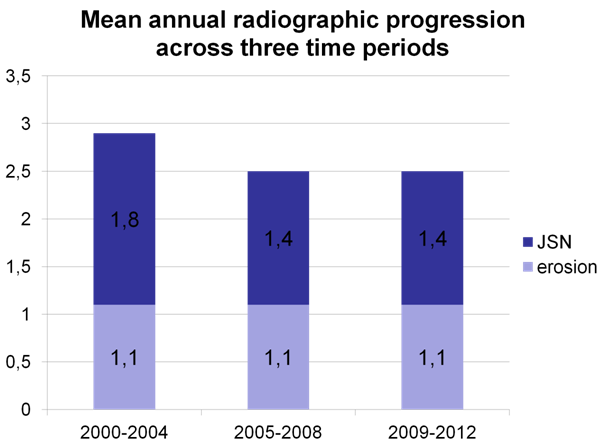Session Information
Session Type: Abstract Submissions (ACR)
Background/Purpose: Progression of joint damage as measured radiographically is a hallmark of rheumatoid arthritis (RA), and its reduction a key claim for traditional and novel antirheumatic drugs. Data from clinical trials may be interpreted to indicate that the observed progression of RA has decreased over the past two decades.1 Although these observations mainly stem from clinical trials, it has been hypothesized that RA in general may have become a less destructive disease.
It was the aim of this study, to evaluate the frequency and degree of radiographic progression in real life routine RA patients over the past decade.
Methods: RA patients of our outpatient clinic, who had two x-rays performed over a three to five year interval between the years 2000 and 2012 were included. X-rays of the hands and feet were scored according to the Sharp van der Heijde (SvdH; range 0-448) method.2 Clinical and demographic data were collected from the patients’ charts. Patients were separated into three periods of time (2000-2004, 2005-2008, 2009-2012) and the annual radiographic progression was calculated based on the observed progression in these periods. Disease activity was assessed using the time averaged clinical disease activity index (CDAI). The mean number of joints with radiographic progression per patient, as well as the mean grade of progression per joint (erosion/joint space narrowing, JSN) were evaluated. Lack of progression was defined as no progression in total SvdH.
Results: Of the 444 patients included (mean duration of RA 7.4±9.4 years, 64.8% rheumatoid factor positive, 63.7% ACPA positive), 406 (91.4%) showed radiographic progression over a mean of 3.8±0.6 years. We found no significant difference neither in clinical nor in radiographic results comparing patients between the three time periods. In all progressors we found no difference in rates of annual radiographic progression, erosion score, or JSN, within the three different time periods (Figure 1). Although the annual rate of progression was stable, baseline SvdH scores decreased across the three periods (43.2±57.4 2000-2004 vs 43.0±49.7 2005-2008 vs 33.2±48.9 2009-2012).
Conclusion: Only a minority of patients did not progress structurally over three to five years. The temporal trend analysis indicates that on the background of similar average disease activity and similar mix of treatment, the overall annual progression was constant during the last decade. However, in general progression of joint damage was low.
Figure 1: Patients with radiographic progression (n=406) during three time periods. The figure shows the mean annual radiographic progression rates for total SvdH-Score, erosions as well as JSN. There was no significant difference between the different time periods.
Reference List
(1) Rahman MU et al. Ann Rheum Dis 2011.
(2) van der Heijde D. J Rheumatol 1999.
Disclosure:
M. Gärtner,
None;
F. Alasti,
None;
G. Supp,
None;
J. S. Smolen,
None;
D. Aletaha,
None.
« Back to 2013 ACR/ARHP Annual Meeting
ACR Meeting Abstracts - https://acrabstracts.org/abstract/no-secular-trends-in-real-live-radiographic-progression-of-rheumatoid-arthritis-in-recent-year/

